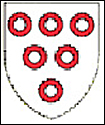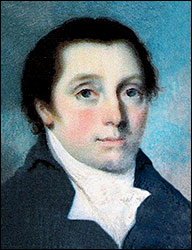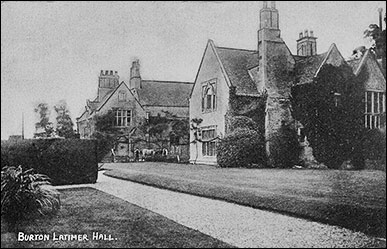| Researched by Janet Meads. With extracts from Bridges History of Northamptonshire and the Victoria County History – Northamptonshire |
|||||||
|
|||||||
|
|||||||
|
In early times it was considered that all land belonged to the Crown and therefore the King was able to give portions of it to whoever he chose. The people who received the portions or manors, had usually performed some great service for the monarch, such as an act of chivalry during battle, support at court, or through friendship or relationship. The land still belonged to the Crown but, as Lord of the Manor, the recipient could pass it on to his heirs or sell the title with its benefits. He or she (women were allowed to inherit the title), as Lord of the Manor was expected to pay the king a Knight's Fee, which in early times meant that they had to provide men from the manor if the king needed soldiers for any cause. The Lord of the Manor often did not live in the manor but had a steward or bailiff to see to the smooth running of his affairs there. The steward would make sure people kept to the local laws about rotation in the fields, how many animals could be owned and when they could be let out into certain pastures, when work was expected to be done by the tenants on his own fields and to collect the rents from the villagers who leased some of the fields and property in his manor. If the Lord of the Manor did not reside in his manor then his steward or the steward's deputy oversaw the twice-yearly View of Frankpledge, which was a local court for the purpose of checking everything was done according to the custom in the village and that offenders were made to make good any damage or put wrongs to right. A town or village was often divided into more than one manor either through sale or inheritance, as was the case in Burton Latimer after 1221 until 1842. In the reign of Edward the Confessor (1042-1066), Earl Ralph, probably the Earl of Hereford, held 8½ hides of land, which constituted, until the first half of the 13th century the whole of the Manor of Burton, and paid the service due from 1½ Knight's Fees. In 1086 the manor was held directly from the king by Guy de-Reinbuedcurt who came into This grant, which was continued to Alan's successors, evidently caused confusion as to the payment of scutage. By the 11th century it was becoming increasingly difficult to enforce the obligation of each of the king's tenants to provide a military force in support of the Crown, scutage meaning shield-money was introduced to pay for mercenaries. The money was recouped from the manor tenants in the form of a levy or tax. In 1173-74 an inquiry was ordered as to the fee which Roland de Dinant held of the king. Before 1190 the manor had passed to his nephew and heir, Alan, the son of his sister Emma and Robert de Vitry. He seems to have died shortly after and The manor then passed to Thomas Malemaines, the husband of Jeane, a granddaughter of Emma de Vitry, and one of the daughters of Eleanor de Vitry by her second husband Gilbert de Tellieres. Malemaines went to In the meantime Margery, the daughter and heir of Richard de-Reinbuedcurt, married Robert Foliot and their descendants continued to return Margery, the grand-daughter of Robert Foliot, brought their rights in the manor to her husband Wischard Ledet, who answered for the Foliot barony in 1210-12. In 1215 his lands were seized by King John and the Northamptonshire holdings were granted to Hugh Neville. Ledet, however, recovered It seems clear however, that about this time, a division of the manor was made between the heir of Wischard Ledet and the successors of Alan de Dinant. The former relinquished the overlordship of the whole manor and retained a third of the township of Burton, which formed a separate manor, held directly from the Crown, in demesne (demesne = the land he did not let out to other tenants) as half a Knight's Fee. The smaller manor went to Wischard Ledet's heir, his daughter Christian, the wife firstly of Henry de Braybroc and then of Gerard de Furnival. She outlived both her eldest son Wischard, who took the name of Ledet, and his son Walter, so that on her death between 1266 and 1270 her heirs were Walter's daughters, Alice and Christian, the wives of the brothers William and John Latimer, and the manor was apparently assigned to Alice. In the meantime this manor had been subinfeudated (sub-tenanted). In 1242 it was held by Henry de Aldwinkle, probably only for life, since it was given, possibly in the lifetime of Christian, to her younger son Gerard de Furnival. He gave it to his eldest daughter Christian, the wife of William de Aylesford or Eylesford, who paid the Latimers rent of one ounce of silk or twelve pence a year. The younger Christian, as a widow, apparently granted it both to Gerard de Furnival and to John Devereux and, though an ensuing law suit in 1283 was decided in favour of Furnival, Devereux evidently obtained a further grant of it for life, as he died seized (possessed of his land) in 1316. It reverted to Christian's son, Gerard de Aylesford and passed in direct succession to first Edmund, then John and then John de Aylesford. The latter, granted all his rights in the manor in 1369 back to his overlord William, Lord Latimer, the great-grandson of Alice Ledet. On the death of Lord Latimer's widow in 1389, it passed to their daughter Elizabeth and by her marriage to the Nevils who held it until the death of John Nevil, Lord Latimer in 1577. It was then inherited by Catherine, the eldest of his four daughters and heirs, and wife of Henry, Earl of Northumberland. She did not live in the manor but her steward or his deputy oversaw the management of her property and lands in
Nicholas Malesmaines obtained livery (the right to sub-let) of the manor before 1225, and it was probably during his lifetime that the division of the Manor of Burton already mentioned was made. Before 1225 he leased the manor and then forfeited it. In 1228 it was granted to William Marshall, Earl of Pembroke, on behalf of his brother Richard Marshall on whose death in 1233 it was granted during the king's pleasure, to Gilbert de Segrave. In 1234 however, Nicholas Malesmaines obtained restitution of the manor and in 1236 he apparently held the whole of the 1½ knight's fees. He died before 1240 and his widow, Beatrice, seems only to have held the smaller manor for her life. His heir, presumably his daughter, was Ela, the grand-daughter of Thomas Malesmaines and wife of Robert de Plesset or Plessey. On the death of Nicholas's widow Beatrice, after 1284, the manor was held in direct descent by John, son of Robert and Ela who died 1313, Edmund who died 1327, Nicholas who died 1356 and John who was succeeded by his brother Nicholas Plessey, a minor, who died in 1362. It then passed to his sister Joan, the wife of John Hawely. Their son John died without issue, and after the death of John Hawley in 1399 the reversion of the manor belonged to Joan's uncle, Peter Plessey who granted it to John Plessey of Shapwick, Dorset, whose son John, came into possession. In 1406 another John succeeded and on his death in 1417, it passed to John Camwell, son of Joan the sister of the first John Plessey of Shapwick. His son Robert and grandson William succeeded him, but William sold Burton Plessey in 1496 apparently to the use of Nicholas Boughton, who died seized in 1519. His son Edward sold it to Sir Nicholas Vaux who held it when he died in 1523. The Vaux family kept it until the death of Edward, Lord Vaux of Harrowden, when it passed under a settlement of 1646 to Nicholas Knollys, Earl of Banbury. His son Charles sold it to Christopher Cratford and John Kenricke in 1687. It changed hands frequently at this time. Early in the eighteenth century John Whiting was Lord of the Manor and he left the Manor of Burton Latimer alias Placey to his son Watkin in his will dated 1721. It is difficult to trace the title of Lord of the Placey Manor from this time. In 1803, at the time of the Inclosure allotments in Burton Latimer, the Commissioners who were dealing with the awards reported that the Duke and Duchess of Buccleuch, Joseph Harper and William King all claimed to be Lords of the Manor of Burton Latimer. It seems that Harper and King established their rights to titles but not the Duke and Duchess. Following its disposal by William King, the Placey Manor title passed through the Ward, Boughton and Leigh families of Warwickshire and Northamptonshire who owned property in Great and Little Addington among other places. In 1842 the Placey or Plessy Manor plus other properties were put up for auction and were bought by the Revd. Latimer Harper. As previously mentioned he later inherited the Latimer Manor, so bringing the two manors of Burton Latimer back into the same ownership once again.
. |
|||||||



